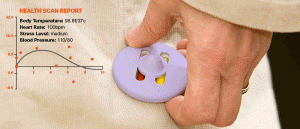When I upgraded to my Samsung G6 cell phone, I was intrigued at the number of health bio-sensors included in the stock, “Samsung Health” phone app. A pedometer is welcome but expected. I was prepared to be amazed if the cell phone could measure my blood pressure or blood glucose, but I soon discovered these options were simply a place to manually record medical findings – though a convenient way to do so on your phone with fields to also record context such as recent exercise or current medication.
When exploring the heart rate and blood oxygen (SpO2) options I was fascinated to see the onscreen instruction to hold my index finger still over the camera’s flash. Using the intense light, the cell phone bio-sensor was able to pick up a pulse from my finger (confirmed accurate by a different finger on my carotid). I had a harder time imagining measuring SpO2 until I read this online:
“The pulse oximeter sensor shines red light and infrared light directly into your skin, and the ratio of infrared light to red light that gets absorbed (and not returned to the sensor) allows the module to determine how much oxygen there is in your blood. This is because the infrared light is actually absorbed by the hemoglobin (a protein in red blood cells), and the amount of oxygen present affects infrared absorption.”
However, what still stumped me was the the cell phone bio-sensor that offered to measure and track, “stress.”
As a behaviorist, I am quite interested in ways to measure stress since many unwanted animal (and human) behaviors result from increased stress. In researching the mechanism, I found that some bio-sensors can measure stress via slight increases in conductivity in skin due to micro increases in perspiration (due to Stress Hyperthermia?), esp in the hands and feet. (Read about stress-measuring socks at Science Daily.)
However, I had a very hard time imagining my cell phone doing electro-chemical analysis involving moisture! Further investigation revealed that the true nature of the Samsung bio-sensor is that it measures variability between heart contractions. Because veterinarians are accustomed to sinus arrhythmias as normal in dogs, we really can’t relate to this as a useful measurement. What really surprised me is that in humans under stress, the regularity between heart beats increases presumably due to fight or flight trumping minor influences from innumerable other factors.
The future of Veterinary Bio-sensors is enormous, and probably a “trickle down” from human medicine. One interesting development is internal bio-sensors. Here is one example:
“Silicon Valley-based Proteus Digital Health makes an “ingestible sensor” – a tiny sensor the size of a grain of sand that’s embedded into a pill and ingested at the same time as your medicine. The metals in the sensor react with the natural acids in our stomach to create an energy current that transmits data to a wearable monitor, or skin patch. The patch sends this data, via Bluetooth, to a secure app telling caregivers if a patient actually took their medicine, and when. Says Proteus CEO Andrew Thompson, “We can turn taking a medicine into a digital event.”
Here’s my veterinary futurist request – monitor client compliance of Rx administration…
When dealing with behavior cases, I now test one behavior medication, then at recheck, assess the response to determine if staying or moving to a different Rx. What I want in the future is to have the patient take the behavior Rx plus a marker pill that sends notification to the ID chip. Then at recheck, a simple chip-scan imports into the medical record the frequency of medication actually delivered.
Rolan
